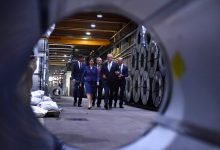Prime Minister Scott Morrison has cited a range of misleading “facts” as he attempts to dismiss concerns raised by NSW energy minister Matt Kean of growing rumblings within the federal Liberal party caucus over a lack of action on climate change.
The Morrison government has refused to commit to increasing its ambition on climate change, maintaining its soft emissions reduction target even in the wake of devastating drought and bushfires that have ravaged Australia over the summer.
Morrison’s comments in separate interviews with ABC and Nine’s Today show come after Kean told Sky News that “some of the most senior members of the government” had been raising concerns with him over the lack of meaningful climate policy at a federal level.
The federal coalition has been effectively paralysed by internal rifts when it comes to climate and energy policy, and is beholden to the Far Right – a noisy backbench group that includes climate change denier Craig Kelly and prefers to see the party “blown-up” rather than adopt a meaningful climate policy.
But Kean claims there is a group within the federal Liberal caucus that is eager to see Australia seize the economic opportunity that renewables can offer, to become an “energy superpower for the rest of the world,” mirroring comments made by economist Ross Garnaut.
When asked about those comments on Monday, Morrison was dismissive.
“Matt Kean doesn’t know what he’s talking about. He doesn’t know what’s going on in the federal cabinet. Most of the federal cabinet wouldn’t even know who Matt Kean was,” Morrison told ABC Radio’s AM program.
Defending his government’s climate policies, Morrison told Today that “we will reduce our carbon emissions per capita by half between now and 2030. We are leading the world on renewable investments in technology and energy in this country. These are the facts Karl.”
However, neither of these “facts” are true.
Based on the government’s latest emissions projections, emissions per capita are set to decline by less than 20 per cent between 2019 and 2030.

According to documents from the environment department, the government anticipates that Australia’s per capita emissions would roughly halve between 2005 and 2030. Morrison was incorrect to say they would be halved starting from “now”, with the department giving the Morrison government an extra 15 years to reach the target.
Labor’s shadow climate minister Mark Butler said that the “emissions per capita” measure was mostly meaningless, as the measure has largely been driven by population growth, rather than any action taken to reduce emissions.
“This government is obsessed with characterising emissions reduction as “per capita” – as if the effects of climate change will only be dependent upon our population size,” opposition climate spokesperson Mark Butler said.
“What the government’s emissions data actually confirms is Australia will not meet our Kyoto commitment to cut emissions by 5 per cent next year.
“In fact, our emissions reduction will amount to little more than a rounding error of 0.3 per cent, putting the lie to the Prime Minister’s claim that we are meeting and beating our international commitments,” Butler added.
Additionally, Australia no longer ranks amongst the world’s leading investors in renewable energy. Researchers from The Australia Institute have argued that this claim has never been accurate, even after cherry-picking the most convenient figures, Australia ranked second or third in terms of per capita investment.
But it is clearly no longer the case that Australia could even rank that high according to the latest analysis from Bloomberg New Energy Finance, as the end of the Renewable Energy Target, and the lack of meaningful federal policy contributed to a collapse in new projects.
The fall in investment was led by a dramatic drop off in large-scale wind and solar projects, which both saw new capacity additions more than halve in 2019.
“Instead of spending his time fudging the numbers the Prime Minister should show some leadership, control the civil war within the Coalition over climate action and put in place policy that will actually reduce Australia’s emissions,” Butler added.
Despite coming from the same side of politics, Kean has sought to forge his own path in NSW on climate change policy and renewable energy investment.
At the Smart Energy Conference in December, Kean warned those opposing renewable energy were about to experience a similar fate to that of Kodak, the camera film company that failed to foresee the rise of digital cameras.
“We cannot allow ideology and politics to get in the way of our clear path to economic prosperity, let alone the health of our planet to future generations of Australians,” Kean told the conference.
The NSW government plans to establish Australia’s first dedicated renewable energy zone, with a 3,000MW zone planned to be centred around Dubbo in the state’s central-west region. The zone would ensure targeted investment in the necessary enabling infrastructure, including transmissions network infrastructure to support the large investment in renewable generation capacity.
Kean recently flagged via Twitter that the NSW government is also expected to release an electric vehicle strategy in the near future, while we are still yet to see a federal electric vehicle strategy despite one being flagged almost a year ago.










